Higher cooking temperatures can create chemical reactions among amino acids, creatines, and sugars — reactions that may produce dangerous compounds that can damage our DNA.
We know that cooking food has some benefits:
- It can make food safer
- It can concentrate tastes and flavors
- It can reduce spoilage
- It can soften tough foods
- It increases the amount of energy our bodies can get from food
- It breaks starch molecules into more digestible fragments
- It denatures protein molecules
But before we get too excited about cooking, the modern diet can be overwhelmingly heat-processed. Higher cooking temperatures can create chemical reactions among amino acids, creatines, and sugars — reactions that may produce dangerous carcinogens and mutagens (compounds that can damage our DNA).
Now suddenly we have “unhealthy” compounds created in otherwise “healthy” foods — stuff like potatoes, fish, whole grains, etc.
Don’t freak out and throw your barbecue grill off the balcony just yet. Let’s start by learning more about what these compounds are, and how they work.
Cooking creates chemical compounds
Heat plus food molecules can create several products in the process of chemical conversion known as cooking. (And you thought you were just slapping a burger on the grill! Now you can say “I am chemically converting proteins!” Fancy.)
Some of the most notable end products include:
- Heterocyclic amines and polycyclic aromatic hydrocarbons
- Advanced glycation end products
- Acrylamide
Let’s look at each of these in more depth.
Heterocyclic amines (HCAs) and polycyclic aromatic hydrocarbons (PAHs)
What are they and where do they come from?
HCAs are made when creatines and amino acids (both found in meats) react together with heat. PAHs include over 100 different compounds formed by the incomplete burning of organic matter (e.g., oil, gas, coal, food, etc.) at temperatures in excess of 392 degrees F (200 C).
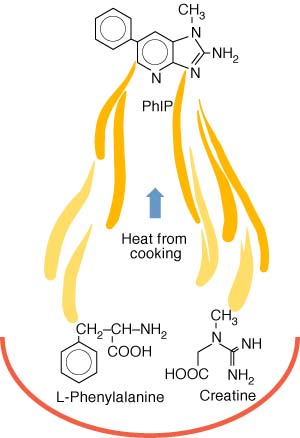
Thus, raw foods don’t have HCAs nor PAHs. Indeed, more than 90% of our exposure to HCAs and PAHs comes from cooked food.
The most concentrated sources include grilled/charred meats and fish. However, ready-to-eat commercial breakfast cereals, processed carbs, fats/oils, and tobacco smoke also contain high amounts of PAHs. PAHs in vegetables and fruits occur mostly due to environmental contamination of air and soil.
Four factors influence HCA formation:
- Type of food
- Cooking method
- Temperature
- Cooking duration
Temperature is the most important factor. Problems begin at 212 F (100 C), with the real nasty HCAs forming at about 572 degrees F (300 C).
PAH formation is influenced by:
- Temperature of cooking
- Duration of cooking
- Type of fuel used in heating
- Distance from heat source
- Fat content of the food
Essentially, the hotter and longer a meat is cooked, the more HCAs and PAHs. Direct heat methods like frying and grilling produce more than indirect-heat methods like stewing, steaming or poaching.
Studies estimating the intake of HCAs show an average 26 ng/kg body wt/day for a U.S. population.
Why should we worry about them?
HCAs are on the official list of cancer-causing agents published by the NIH. We’ve known about them since the 1970s — and they are straight up genotoxic, meaning that they work at the DNA level causing mutations, deletions, and insertions. Not good.
Thus far, we’ve identified 17 different HCAs that may increase cancer risk.
Along with heme iron and nitrates/nitrites, HCAs and PAHs may be the major reasons that “meat” is associated with cancer at all. Pickled, smoked, barbecued and processed meats (e.g., bacon, ham, sausage, hot dogs, salami, bologna, luncheon meats, corned beef, etc.) seem to cause the most health problems.
It’s the intake of these meats that are more related to cancer risk than total red meat intake alone. Other dense protein foods (milk, eggs, legumes, and organ meats) have very little or no HCA content naturally or when cooked.
What can we do about them?
We can start by changing our cooking methods. Opt for slower, indirect-heat methods of cooking such as poaching, stewing, braising, or steaming.
We can consume more plants in our diets. Plant-based diets typically contain insignificant amounts of HCAs and moderate amounts of PAHs. Those eating a higher raw plant-based diet tend to consume even lower amounts.
HCAs and PAHs can be removed from the body via detoxification in the liver. A plant-based diet can decrease the extent of DNA damage and oxidation from these compounds. Thus, not only do plants have fewer HCA/PAH-creating compounds, but they also help fight the effects of any of these compounds once created.
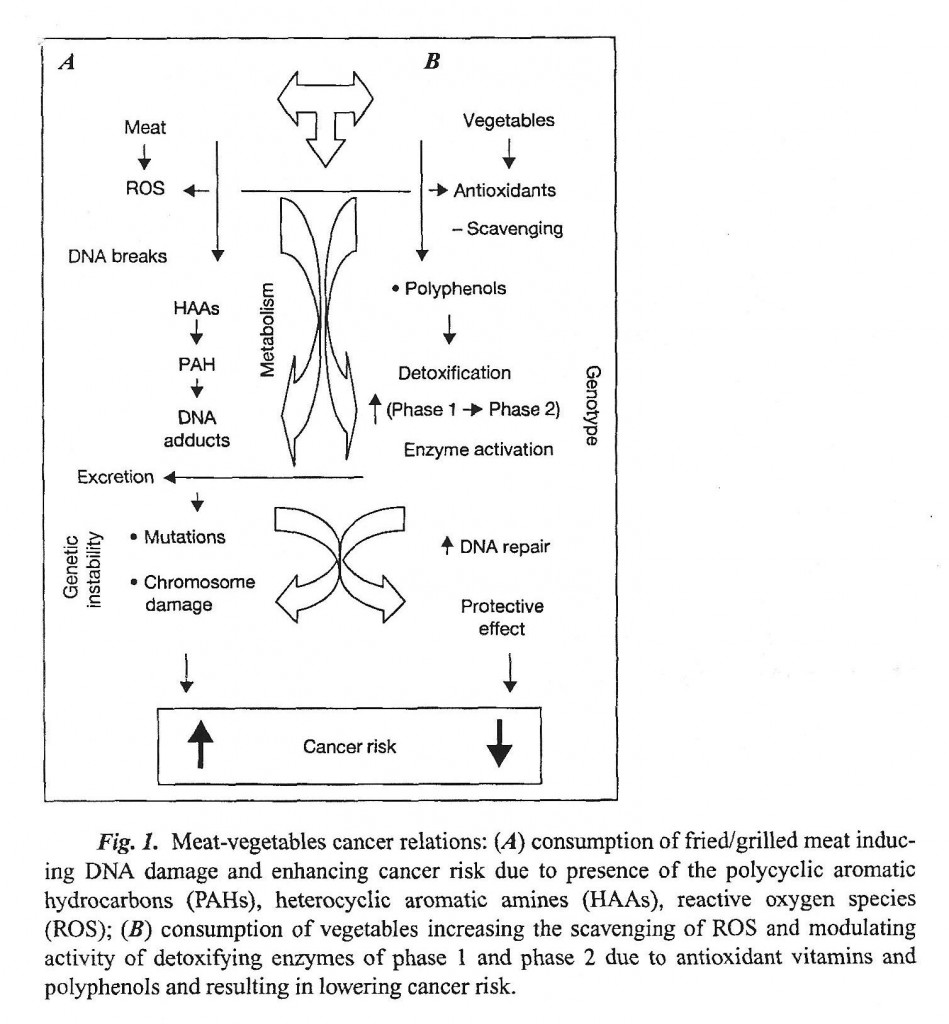
Experts recommend a ratio of greater than 2:1, plant foods:meats as the minimum recommended intake to support the body’s fight against cancer development. The protective effect seems to increase with ratios greater than this (3:1, etc.). The more plants, the less cancer.
Advanced glycation end products (AGEs)
What are they and where do they come from?
When you slap a burger on the grill and char it up good, pop a slice of bread into the toaster, or roast a marshmallow while camping, you’re creating the Maillard reaction, which occurs when sugars and proteins in the food react together with heat.
Sadly, while possibly increasing the scrumptiousness of these foods (which, by the way, also creates the characteristic flavours of caramel), this reaction can lower the nutritional value and create toxic/carcinogenic end products, including advanced glycation end products (AGEs), also known as glycotoxins.
Now take a look at the grill after cooking, or try to pry the sticky marshmallow off the campfire rock after it dropped from your roasting skewer. See how all those yummy brown roasty bits have glued themselves to the surface? That’s what happens in your body with AGEs. Stuff starts to stick together.

AGEs can be created inside our body with aging and high blood sugar. But we also eat AGEs. Virtually any food exposed to extreme heat can scorch, generating AGEs.
Adding dry heat to uncooked food can increase that food’s AGE content by 10 to 100 times. But AGEs can be produced during pasteurization, drying, smoking, frying, microwaving and grilling. Any food that contains sugars, fats, and proteins is fair game.
The standard American diet likely contains about 16,000±5,000 kU of AGEs each day. This is three times higher than the safety limit advised by professional organizations. Plant-based diets contain lower amounts, unless they are built upon processed and fried foods. Diets with more raw foods typically contain minimal AGEs.
| Foods with the highest AGEs | Foods with the lowest AGEs |
|---|---|
| Meats (note: tofu cooked at high temperatures is also quite high, but slightly lower than most meats) | Unprocessed grains |
| Butter | Legumes |
| Processed cream cheese | Breads |
| Margarine | Milk/yogurt products |
| Mayonnaise | Vegetables (especially with no added fats) |
| Refined oils | Fruits |
| Roasted nuts |
Why should we worry about them?
Once in the body, AGEs have been shown to negatively affect a majority of cells, tissues, and organs (see diagram below). Fewer AGEs circulating in the system means a lower risk of diseases like Alzheimer’s, kidney, cardiovascular, and diabetes.
In animal models, AGEs contribute to:
- inflammation
- atherosclerosis
- kidney damage
- neurodegenerative disease
- muscle loss
- cancer cell metastasis
- insulin resistance
- alterations in cell receptors
- a shorter life
- oxidation
However, some suggest that rats/mice aren’t accustomed to the intake of heated food and might not be an accurate study model that translates to humans.
10% of dietary AGEs are absorbed. Of this 10%, about 1/3 are excreted in the urine within three days. This means they probably hang around the body wreaking havoc.
This will help you put it in perspective (click to enlarge):
Sources: Uribarri J, et al. Advanced glycation end products in foods and a practical guide to their reduction in the diet. J Am Diet Assoc 2010;110:911-916; Goldberg T. Advanced glycoxidation end products in commonly consumed foods. J Am Diet Assoc 2004;104:1287-1291.
What can we do about them?
“AGEs are ubiquitous and addictive, since they provide flavour to foods. But they can be controlled through simple methods of cooking, such as keeping the heat down and the water content up in food and by avoiding pre-packaged and fast foods when possible.”
—Professor Helen Vlassara, AGE researcher from the Mount Sinai School of Medicine
Method of food preparation is critical here. Heating foods over 446 degrees F (230 C) seems to be the most problematic.
For example, the same 90 gram chicken breast can vary from 1000 to 9000 AGEs:
- Frying, grilling, roasting, or broiling: 4000 to 9000 AGEs
- Boiling, steaming, or stewing: 1000 AGEs
To immediately start consuming 50% less AGEs, poach, stew, or steam meals. This 50% reduction can decrease plasma levels of AGEs by 30% within a month.
Thus:
- Cook food at a lower temperature
- Don’t char it or cook the heck out of it
- Avoid processed foods, which have more AGEs — home prepared versions (such as French fries) have fewer AGEs compared to their processed counterparts
- Use liquid in cooking (for example, in braising)
- Use acids such as lemon juice or vinegar in marinades and cooking liquid — these will also help decrease AGE formation
Acrylamide
What is it and where does it come from?
Acrylamide is another one of the toxic Mallard reaction end products, forming when asparagine reacts with naturally occurring sugars in high carbohydrate/low protein foods subject to high cooking temperatures. Reactions start at 248 degrees F (120 degrees C).
The higher the cooking temperature and the longer the cooking duration, the more acrylamide.
Most foods that contain acrylamide are cooked commercially and contain the acrylamide when purchased. Think French fries, potato chips, breakfast cereals, crackers, pretzels, coffee, pastries, etc.
If those foods are part of your regular food rotation, you’d better be worried about more than acylamide, most notably grease stains on your couch, grease chunks in your arteries, and knowing the cashier at Winchell’s Donuts on a first name basis.
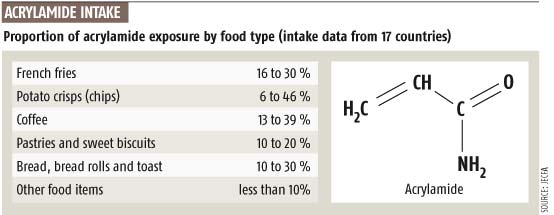
But we can’t just blame the food manufacturers, since acrylamide is formed during some home food prep. Significant formation requires temperatures greater than 248 degrees F (water simmers at 190 – 200 degrees F and boils into steam at 206 – 212 degrees F).
Diets high in baked or fried starchy foods will contain larger amounts of acrylamide. Diets including more animal products and raw plant foods will be lower.
We can also inhale and otherwise absorb this stuff. You’ll find acrylamide in body lotions, shampoos, tobacco smoke, food packaging, and human breast milk (if mom is ingesting acrylamide).
Why should we worry about it?
Early animal research indicates that acrylamide may be genotoxic, carcinogenic, neurotoxic and create reproductive problems. It’s currently classified as “probably carcinogenic.”
Still, results from human studies indicate that ingestion of acrylamide at current levels fails to produce any measurable neurotoxicity or increases in cancer.
Average intake is estimated to be 0.3 to 2 μg acrylamide/kg bodyweight/day for developed countries. The WHO concluded that an adequate margin of safety at 1-4 μg /kg bodyweight over a lifetime for humans.
What can we do about it?
While we don’t know for sure about acrylamide consumption and disease, it might be best to limit exposure and err on the side of caution.
And notice that the acrylamide-containing foods aren’t all that great for you anyway.
Summary and recommendations
This article is about majoring in the minor. HCAs, PAHs, AGEs, and acrylamide are nutritional details. So make sure to prioritize.
- If your diet is based on processed foods, meats and alcohol – then don’t worry about AGEs in your morning bran flakes. You’ll probably get a disease related to your overall lifestyle first.
- If your diet is already based on whole, unprocessed foods, including lots of plants – then you can start tweaking the finer points of your food preparation methods.
The information in this article adds to previous evidence that a diet based on highly processed foods/meats isn’t the best option for health and can contribute to a range of conditions, from obesity to cancer.
What to do
No matter your style of eating, the highly processed/heated stuff tends to be the most dangerous, including potato chips, French fries, commercial breakfast cereals, grilled meats, fast food meats, deli meats, etc. There are many reasons to avoid this stuff — this is just one more.
When preparing foods, consume unprocessed items that are boiled, steamed, stewed, sprouted, fermented or poached. Avoid high temperature grilling, broiling, roasting, and frying.
Reduce carcinogens by doing the following:
- Use leaner meats
- Use an acidic marinade for meats
- Use lower temperatures and moist heat
- Don’t show off for your grilling buddies with flare-ups
- Don’t overcook
- Hey, why not eat a veggie burger and a regular burger instead of two regular burgers?
It would be impossible to eliminate all carcinogens in food, so don’t think you’re above the system. Further, while high temperatures can create some harmful compounds, it can also destroy harmful compounds. There is a trade off. No need to opt for chicken sashimi just yet.
Extra credit
The AGE content of infant formula is higher than that of human or cow’s milk.
Some food derived AGEs may have beneficial antioxidative and desmutagenic (mutation-fighting) properties.
The main dietary advice that the American Institute for Cancer Research gives is: “Choose mostly plant foods, limit red meat and avoid processed meat.”
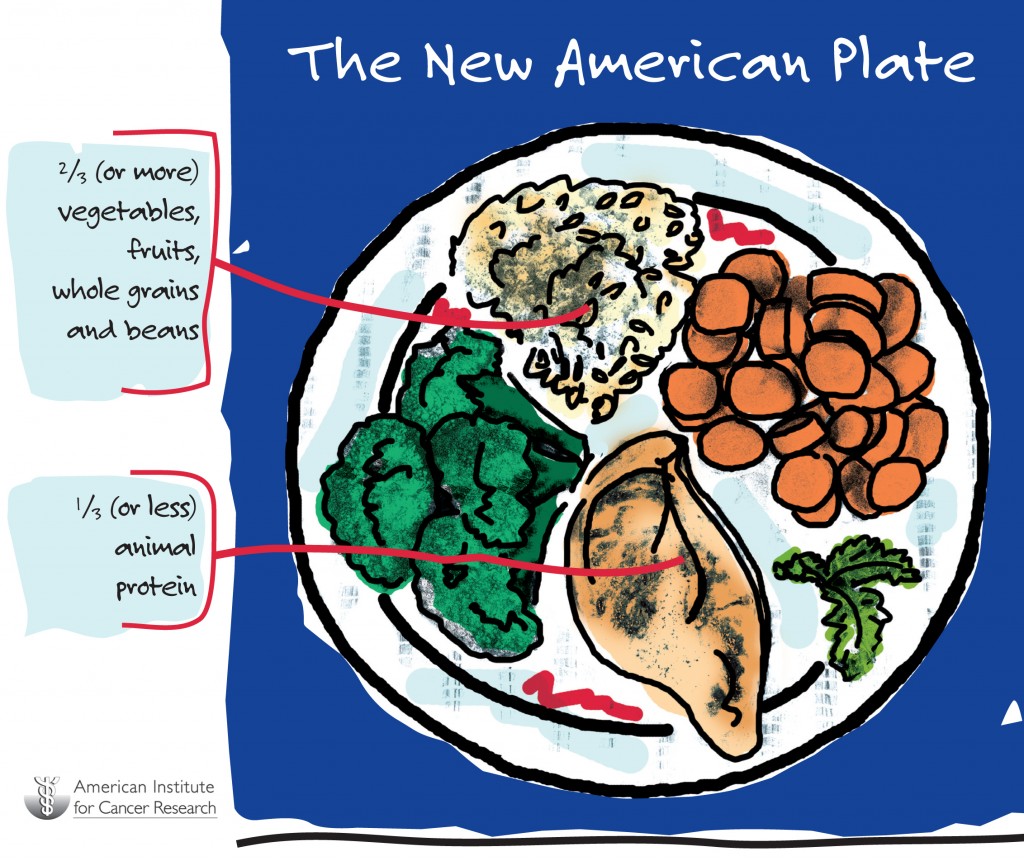
HCAs and PAHs seem to be more harmful than acrylamide and AGEs.
Tea and yerba mate may inhibit the formation of AGEs.
Microwaving increased AGE content more rapidly compared to conventional cooking methods in one study.
High levels of methylglyoxal, an intermediate product of the Maillard reaction, are found in commercial soft drinks that contain high fructose corn syrup.
Almonds in most raw almond butters from California are required to go through steam pasteurization. This only raises the temperature of the nut to around 160 degrees F (71 C).
Low carb baked goods with sugar alcohols (maltitol, xylitol) don’t create Maillard reactions. (Unfortunately, the trade-off is often intestinal distress. Maybe just consider cutting back on the pancake intake altogether.)

References
Click here to view the information sources referenced in this article.
If you’re a coach, or you want to be…
You can help people build sustainable nutrition and lifestyle habits that will significantly improve their physical and mental health—while you make a great living doing what you love. We'll show you how.
If you’d like to learn more, consider the PN Level 1 Nutrition Coaching Certification. (You can enroll now at a big discount.)


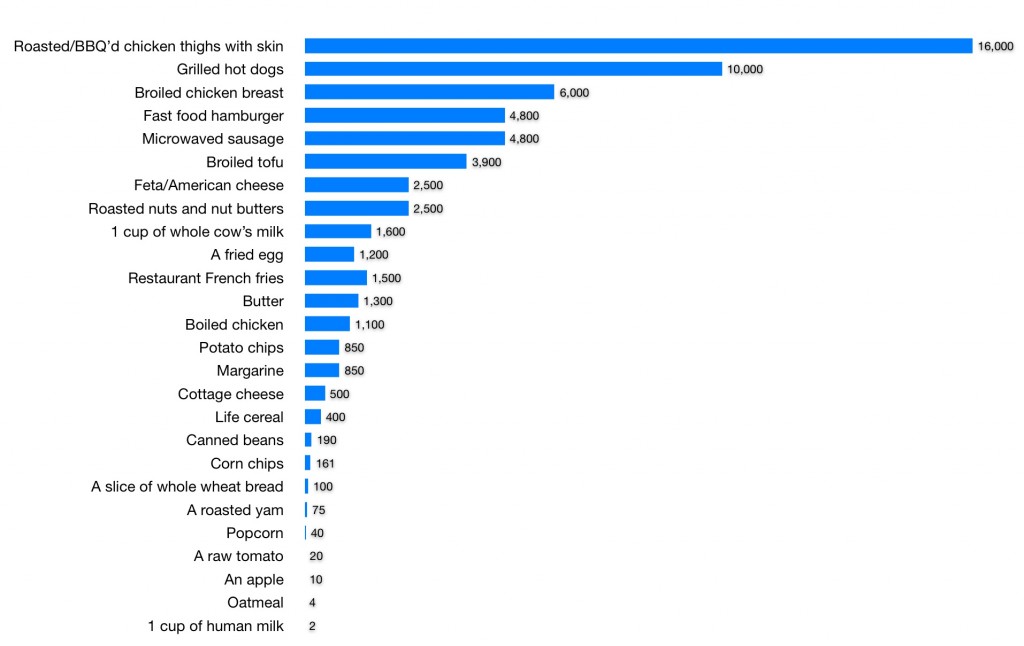
Share